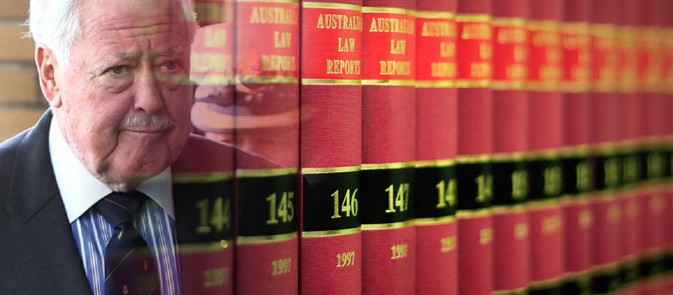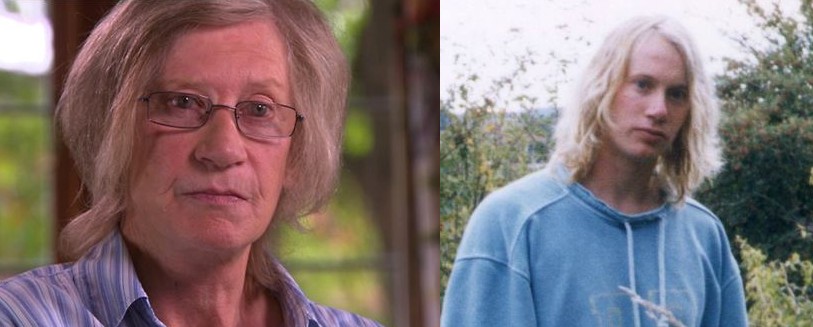 William Cox, Chief Justice of Tasmania from 1995 to 2004
William Cox, Chief Justice of Tasmania from 1995 to 2004
by Mary W Maxwell
Martin Bryant was apprehended on Monday, April 29, 1996, at 8.30am, as he emerged from Seascape cottage with his back on fire. He was taken to the hospital. He was within a few days of reaching 29 years of age. His IQ is reported to be 66, in the lowest 2% of the population.
Martin pleaded not guilty but after months of solitary confinement, he changed the plea to guilty. John Avery was his new lawyer at that time and funnily enough he, Avery, has since been in prison for fraud.
Below are Chief Justice William Cox’s official comments on passing sentence, in the case of R v Martin Bryant, 22 November 1996. All I have done is abridge it and add bolding. I add italicized bolding to note the areas in which Bryant is described doing something that no low-IQ person could conceivably do.
I now quote Chief Justice Cox of the Supreme Court of Tasmania:
In consequence of the tragic events at Port Arthur on 28 and 29 April of this year and of his plea of guilty, the prisoner stands for sentence in respect of: the murder of no less than 35 persons… the infliction of wounds upon [11] persons… four counts of aggravated assault; one count of unlawfully setting fire to property, namely a motor vehicle which he seized at gun point from its rightful occupants, all of whom he murdered; and for the arson of a building known as “Seascape”, the owners of which he had likewise murdered the previous day.
After having heard the unchallenged account of these terrible crimes narrated by the learned Director of Public Prosecution and his Junior, an account painstakingly prepared by them from the materials diligently assembled by the team of police and forensic investigators… it is unnecessary for me to repeat it in detail ….
The prisoner, it is clear, a lengthy period of time before the day on which it was carried into effect, formed the intention of causing the deaths of [David and Sally] Martin against whom he had long harboured a grudge.
… Indeed he seems to have contemplated mayhem of such a drastic kind that it would in all probability provoke a response which would result in his own death. In furtherance of his intention, he acquired high powered weapons and embarked with three of them, a very large supply of ammunition and…., a hunting knife, two sets of handcuffs and rope.
In addition he carried large quantities of petrol and acquired a cigarette lighter en route. As he was not a smoker, the inference is that he intended to arm himself with the means of igniting the petrol and that this was intended to be used unlawfully causing damage to some property….
Arrived at [Seascape], he shot [the Martins] dead and continued on to Port Arthur. Here, at the Broad Arrow Cafe, he consumed a meal on the balcony outside. … He produced from the bag an AR15 rifle fitted with a 30-shot magazine
….in the first 15 seconds he discharged 17 rounds, thereby causing the deaths of 12 people…. He continued to discharge the weapon at close quarters before leaving the premises approximately 1 minute and 30 seconds after firing the first shot….
The spectators who escaped physical injury were subjected to emotional trauma of the most stressful kind. …. In the car park, where there were a number of buses, he shot the driver of one in the back, killing him; and fired at groups of people….
He then exchanged the Armalite rifle for a semi-automatic .308 FN rifle or SLR which was in the boot of his car parked nearby. … The prisoner killed two further visitors and by firing at them shots which, in some cases, connected….
From here he moved up the road in his car and en route encountered Mrs Mikac and her two daughters, murdering all three in the heart rending circumstances already described by the Director of Public Prosecutions.
At the toll booth he murdered the four occupants of a BMW, pulling the two female passengers seated in it from the car and shooting them at close range. He then commandeered the car, transferring from his own car some of the items in it, including the AR15 rifle, a quantity of ammunition, the two handcuffs and some petrol.
Thereafter he fired two shots at a car which had been reversed by the driver on appreciating the situation. In the vicinity of the toll booth, 11 spent cartridges fired by the prisoner were later recovered.
A short distance from the toll booth a white Corolla occupied by Mr Glen Pears and Miss Zoe Hall was parked at the service station.
The prisoner brought the vehicle he was driving to a halt …. He alighted with the SLR and tried to extract Miss Hall from the passenger seat. When Mr Pears attempted to intervene, he was forced into the boot of the prisoner’s stolen vehicle. Miss Hall was then murdered in a series of three rapid shots from the hip.
…. the prisoner moved on, returning to Seascape. On the way, and after his arrival, he fired at a number of vehicles causing very grievous harm …. and endangering the lives of nine other people including two police officers called to the scene.
Arrived at Seascape, the prisoner forced Mr Pears, whom he was treating as a hostage, to enter the house, placed handcuffs on his wrists and immobilized….[him]. He then set fire to the stolen vehicle and retreated to the house where … he murdered Mr Pears by shooting him.
Throughout the night he continued to discharge a number of weapons, his own arsenal augmented by weapons belonging to the Martins, and kept at bay the police who were surrounding the house, their response restricted by the belief that both the Martins and Mr Pears could still be alive.
…. Clearly the Martins were not alive at that stage, but the prisoner deceitfully conveyed the impression that they were in telephone conversations with police negotiators. The following morning he set fire to the house, destroying it completely and, while fleeing from it in an injured condition due to burns, was apprehended.
Objectively, it is difficult to imagine a more chilling catalogue of crime….. The repercussions of these crimes have been world-wide. His selection of victims was indiscriminate. He killed and injured men, women and even children. He killed, or attempted to kill, local residents, visitors from other parts of Australia and visitors from a number of overseas countries.
The learned Director of Public Prosecutions has mentioned the impact these crimes have had on individuals immediately affected by the loss of a family member or members, or who suffered physical injury in the course of this shooting rampage. He has also mentioned the effect it had on eye witnesses … who came upon the scene or otherwise had to cope with the injured and dead.
It is proper to record also the anguish no doubt caused to the prisoner’s mother and immediate family. Then there is the effect on the community at large: the shock and disbelief … the feeling of outrage, anger, grief and frustration at not being able to do more to redress the wrong suffered by so many innocent victims. …. the impact upon the victims of crime cannot be ignored.
In this case more than any other I have ever experienced, they demand recognition. In determining an appropriate punishment, the Court is required to have regard to a great many factors…. In the forefront of this case is the prisoner’s mental condition.
The law recognises that if a person is afflicted by a mental disease to such an extent that he is unable to understand the physical character of what he is doing in, for example, firing a weapon at another person, or that he is rendered incapable of knowing that such an act is one which he ought not to do, or if he acts under an impulse which, by reason of mental disease, he is in substance deprived of any power to resist, then he should not be held criminally responsible for an act which, in a sane person, would clearly amount to a crime. Society is entitled to be protected from such a person, but he may not be held criminally responsible.
….Nevertheless, a great number of people who come into a criminal court are abnormal. They would not be there if they were the normal type of average, every day, person. Many of them, he said, are very peculiar in their dispositions, but are mentally quite able to appreciate what they are doing and quite able to appreciate the threatened punishment of the law and the wrongness of their acts and they are held in check by the prospect of punishment.
It is clear on the materials before me that the prisoner falls into the latter category. He is not suffering from a mental illness – certainly not one which rendered him incapable of knowing what he was doing or of knowing that what he was doing was wrong, or one by virtue of which he was deprived of any power to resist an impulse to do the things he did.
… Nevertheless, he clearly has a mental condition which rendered him less capable than those of normal healthy mind of appreciating the enormity of his conduct or its effect upon others. I accept the psychiatric evidence that he is of limited intellectual ability, his measured IQ being in the borderline intellectually disabled range, but with a capacity to function reasonably well in the community.
…. Professor Mullen said of him that his limited intellectual capacities and importantly his limited capacity for empathy or imagining the feelings and responses of others left a terrible gap in his sensibilities which enabled him not only to contemplate mass destruction, but to carry it through.
….It would appear to me that the level of his culpability is accordingly reduced by reason of his intellectual impairment and the disorder with which he has been afflicted for so long, notwithstanding his parents’ earnest endeavours to correct it, which the medical records acknowledge.
That the prisoner, through these handicaps, in combination with a number of external factors beyond his control such as the loss of stabilising influences, has developed into a pathetic social misfit calls for understanding and pity, even though his actions demand condemnation.
The prisoner has shown no remorse for his actions. Though he has ultimately pleaded guilty, it has clearly been done in recognition of the undoubted strength of the evidence against him and amounts to little more than a case of bowing to the inevitable.
… Taking account of the medical evidence and of this lack of insight into the magnitude and effect of his conduct apparent in all his appearances before this Court, I have no reason to hope and every reason to fear that he will remain indefinitely as disturbed and insensitive as he was when planning and executing the crimes of which he now stands convicted.
The protection of the community, in my opinion, requires that he serve fully the sentences which I will shortly impose.
MARTIN BRYANT – on each of the 35 counts of murder in this indictment you are sentenced to imprisonment for the term of your natural life. I order that you not be eligible for parole …. [End of quote]
 Mother Carleen Bryant and son
Mother Carleen Bryant and son
Well, That Was Yesterday But Today Is Today
William Cox, born in Tasmania in 1936, was educated at Xavier College, Melbourne and the University of Tasmania. He served in the Australian Army in Vietnam. In 1995 he became Chief Justice. From 2004 to 2008 he served as Governor of Tasmania. He has recently been appointed to a new post to review the Tasmania’s Integrity Commission.
Per the ABC of 29 November, 2015,
“Attorney-General Vanessa Goodwin said the review, required under law, would consider the operation of the commission and its act.
She said it would also look at ‘other matters relevant to improving ethical conduct and public confidence in authorities’.”
I think the new post will give His Honor the chance to rethink his views of the intellectually disabled boy who did not, in any case, commit the foregoing acts.
I hereby offer to assist him.
— Mary W Maxwell lives in Adelaide. She can be reached at ProsecutionForTreason.com

I suppose I shouldn’t say it, but given that Cox CJ,’s sentencing of Martin Bryant lists many crimes, and since Martin Bryant did not commit them, they must have been committed by someone else.
At least some of the crimes, the 35 murders, do not have a statute of limitations. So someone today could be charged with them.
I’m not going to hold my breath waiting for charges to be brought. But on the other hand I wouldn’t rule it out.
I wonder if all the law professors in Australia would agree that if it now came to be agreed that Bryant didn’t do the murders, there should be a search for the murderer(s). Or do they think we should drop the matter?
Since the whole point seems to be to cover for the fact that someone else did the murders, I expect the authorities would prefer to drop it if it were agreed that Martin didn’t commit them. Or else they’d have to find another patsy, which might be difficult at this point. I just don’t expect they’d agree. It seems highly likely, given the effort put into this prosecution, that someone very high up in the hierarchy is actually responsible.
In your article, the judge accuses a lot but provides absolutely no evidence to back up those accusations. And you might think since his attorney has been convicted of fraud, that a number of people would begin to question the legitimacy of the prosecution and trial…especially when you compare the monstrous and outrageous accusations with the sweetness of Martin’s face.
Yes totaly agree with you! They/he has a lot to answer for, some one or many have to be accountable. Martins life is worth nothing to them and they treat Tasmanians with contempt. The whole story has got to be revealed and let this poor fellow go home to live a normal life…
Agreed, Seculator247, but I didn’t ask what would “the authorities” do; rather, Do all the law professors think we should drop the matter?
I’d even like to hear from just the profs who specialize in criminal law. If a student in their Criminal Law class raised the above question, what would they say? Even strictly hypothetically.
Funnily enough, the new Governor of Tasmania, Kate Warner, was the professor of Criminal Law at University of Tassie.
In this 3.33 minute vid, former Assisitant Police Commissioner Lupo Prinns says he still hopes Martin will tell us why he did it.
Good idea: let’s ask Martin to make a video explaining.
https://www.youtube.com/watch?v=vVQMADuT2Lw
This website http://theaimn.com/ accepts article submissions for publication. I would love to see this work, and others here, replicated on their site to further awareness of as many Aussies as possible. If they choose not to publish, I would love to hear why not. Please?
Thanks, Fair. Dee and i don’t copyright our stuff, so you can do as you like. See at the top of Gumshow homepage, it says:
Providing real news from AUSTRALIA. Feel free to re-post and link the contents of Gumshoe News.